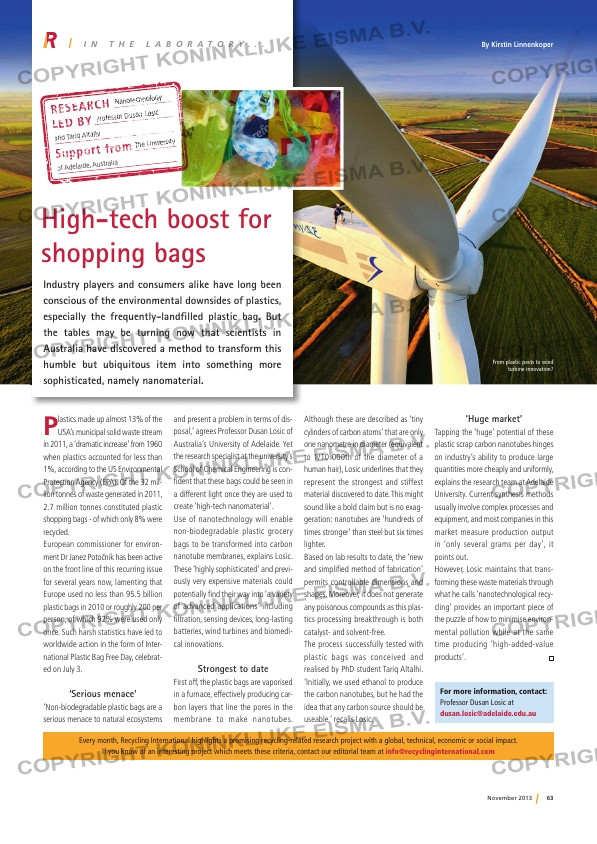Page 63 from: November 2013

63November 2013
I N T H E L A B O R A T O R Y . . .
‘Huge market’
Tapping the ‘huge’ potential of these
plastic scrap carbon nanotubes hinges
on industry’s ability to produce large
quantities more cheaply and uniformly,
explains the research team at Adelaide
University. Current synthesis methods
usually involve complex processes and
equipment, and most companies in this
market measure production output
in ‘only several grams per day’, it
points out.
However, Losic maintains that trans-
forming these waste materials through
what he calls ‘nanotechnological recy-
cling’ provides an important piece of
the puzzle of how to minimise environ-
mental pollution while at the same
time producing ‘high-added-value
products’.
Plastics made up almost 13% of the USA’s municipal solid waste stream
in 2011, a ‘dramatic increase’ from 1960
when plastics accounted for less than
1%, according to the US Environmental
Protection Agency (EPA). Of the 32 mil-
lion tonnes of waste generated in 2011,
2.7 million tonnes constituted plastic
shopping bags – of which only 8% were
recycled.
European commissioner for environ-
ment Dr Janez Potočnik has been active
on the front line of this recurring issue
for several years now, lamenting that
Europe used no less than 95.5 billion
plastic bags in 2010 or roughly 200 per
person, of which 92% were used only
once. Such harsh statistics have led to
worldwide action in the form of Inter-
national Plastic Bag Free Day, celebrat-
ed on July 3.
‘Serious menace’
‘Non-biodegradable plastic bags are a
serious menace to natural ecosystems
Although these are described as ‘tiny
cylinders of carbon atoms’ that are only
one nanometre in diameter (equivalent
to 1/10 000th of the diameter of a
human hair), Losic underlines that they
represent the strongest and stiffest
material discovered to date. This might
sound like a bold claim but is no exag-
geration: nanotubes are ‘hundreds of
times stronger’ than steel but six times
lighter.
Based on lab results to date, the ‘new
and simplifi ed method of fabrication’
permits controllable dimensions and
shapes. Moreover, it does not generate
any poisonous compounds as this plas-
tics processing breakthrough is both
catalyst- and solvent-free.
The process successfully tested with
plastic bags was conceived and
realised by PhD student Tariq Altalhi.
‘Initially, we used ethanol to produce
the carbon nanotubes, but he had the
idea that any carbon source should be
useable,’ recalls Losic.
and present a problem in terms of dis-
posal,’ agrees Professor Dusan Losic of
Australia’s University of Adelaide. Yet
the research specialist at the university’s
School of Chemical Engineering is con-
fi dent that these bags could be seen in
a different light once they are used to
create ‘high-tech nanomaterial’.
Use of nanotechnology will enable
non-biodegradable plastic grocery
bags to be transformed into carbon
nanotube membranes, explains Losic.
These ‘highly sophisticated’ and previ-
ously very expensive materials could
potentially fi nd their way into ‘a variety
of advanced applications’ including
fi ltration, sensing devices, long-lasting
batteries, wind turbines and biomedi-
cal innovations.
Strongest to date
First off, the plastic bags are vaporised
in a furnace, effectively producing car-
bon layers that line the pores in the
membrane to make nanotubes.
High-tech boost for
shopping bags
Industry players and consumers alike have long been
conscious of the environmental downsides of plastics,
especially the frequently-landfilled plastic bag. But
the tables may be turning now that scientists in
Australia have discovered a method to transform this
humble but ubiquitous item into something more
sophisticated, namely nanomaterial.
By Kirstin Linnenkoper
Every month, Recycling International highlights a promising recycling-related research project with a global, technical, economic or social impact.
If you know of an interesting project which meets these criteria, contact our editorial team at [email protected]
RESEARCH
LED BY
Support fro
m
Nanotechnolo
gy
Professor Dusa
n Losic
The University
and Ta
riq Altalhi
of Adelaide, Au
stralia
From plastic pests to wind
turbine innovation?
For more information, contact:
Professor Dusan Losic at
[email protected]
RI-9-In the laboratory.indd 63 11-11-13 10:08



